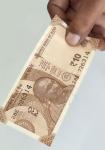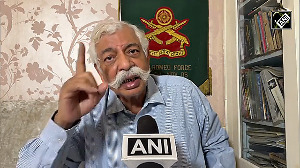It might seem a little trivial to write about the credit policy when more important things like election results occupy much of the nation's attention bandwidth.
My defence is that unlike the last few policies which simply reasserted the Reserve Bank of India's commitment to maintaining the status quo, the policy due on May 18 will be substantially different.
Different since it is likely to contain elements of a new strategy to deal with what appears to be a rapidly changing global economic environment. Hence, it deserves attention.
The perception of a change in the global economic system stems largely from the statements coming from US central bank, the Fed over the last month or so.
While the US GDP growth numbers have been fairly robust for a couple of quarters now, the Fed now seems convinced that this is finally translating into tighter labour market conditions that is likely to feed into rising wage costs and prices.
Thus, while it has chosen to keep interest rates on a leash for now, it seems to be building a case for rate hikes in the future.
Thus in a nutshell, the signs of a recovery in the US appear to be more palpable with its concomitants of rising pricing power and interest rates. The question is: how will this impact on Indian interest rates and what is the likely monetary policy response to this?
There are, however, important qualifications to be made here. The possibility of rising inflation and rates is really confined to the US and the UK; growth numbers in eurozone economies continue to look dodgy and while Japan's growth rates have improved perceptibly in recent quarters, the Bank of Japan has every reason to be squeamish about raising rates at this stage.
Thus, for a while, the global liquidity cycle is likely to display an interesting asymmetry with some of the developed countries tightening money supply in the near future and others retaining their soft bias.
For India, this has an important implication. While there is clearly quite a bit of fund flows between India and the US driven by interest rate differentials, the impact of a rise in US rates on Indian rates is likely to be moderated to a degree by the continuation of a 'soft' regime in eurozone.
Thus there could be some switch from, say, dollar-denominated external borrowings by Indian companies to euro-borrowings. The bottom line is that while there would be some pressures on Indian rates from rising US rates, they would be far less than what they would be if all rates had moved up together.
There are two other caveats here. The signs of tightness in the US labour markets are at best, tentative. Unless there is more evidence of a sustained improvement in US payroll numbers, the Fed might want to hold off from tightening rates at this stage.
The more important issue is that of the appropriate monetary response to rising oil prices. Rising fuel costs are likely to dampen consumer sentiment and spending and could rein in the US recovery.
Pushing up rates in this sort of environment could lead to stagflation, a syndrome of high cost-push inflation and retarded growth.
It might be prudent for the US central bank to keep rates low to prevent this syndrome and learn to live, at least for a while, with higher inflation. Thus, the assumption of a hike in US rates is also somewhat tentative.
In short, the global environment looks not only uncertain but reasonably complex as well in terms of the conflicting forces that are panning out. The May 18 credit policy will reflect Messrs Reddy and company's take on which way these global forces will tilt.
Of course, there are domestic compulsions as well. There appear to be clear signs that manufacturers in a number of sectors no longer have much slack left in their production capacity and further growth in demand is likely to nudge prices up.
Thus 'core' manufacturing inflation is looking up. To compound matters, there are huge amounts of liquidity sloshing around in the system just waiting to abet a price spiral.
Add to this the fact that domestic petrol and diesel prices have been artificially suppressed (with an eye on the ballot boxes) and are bound to go up once a new government is in power and you get perfect conditions for monetary tightening. Thus a rise in the cash reserve ratio or some of the signal rates like the bank rates seem due on May 18.
But there are problems with this monetary policy response if you look hard enough. The first signs of an investment recovery are making themselves visible -- both the machinery and equipment component of the official industrial production index and anecdotal evidence from capital goods manufacturers clearly suggest that Indian companies are expanding capacity.
Capital goods imports have picked up sharply as well. Monetary tightening could dampen this up-tick investment cycle.
Besides, increasing rates could actually be quite counter-productive as far as monetary contraction goes -- higher rates would attract more arbitrage driven funds and jack up liquidity and tend to completely offset the initial impact of the policy measure. This would simultaneously tend to rupee appreciation as well.
If you find yourself between a rock and a hard place, stay calm and do nothing. Given the conflicting pressures on the central bank and the uncertainty of the global environment, this could be a useful operating principle for putting together the May Credit Policy.
Thus the RBI could well choose not to tamper with any of the policy instruments at its disposal. This passivity should not be construed as indifference -- doing nothing just happens to be the optimal response to current conditions. If conditions change substantially, a change in policy tack mid-stream is always possible.
If the RBI chooses to keep its hands off the monetary levers, how are the key monetary variables likely to look over the next few months? Well, inflation is almost certainly likely to look up and with it domestic bond yields, particularly of longer tenors will move up.
If US rates do rise further, some of the arbitrage-driven fund inflows into Indian markets will slow down. The momentum of equity investments in Asia as a whole appears to have slowed this year and if this continues, the pace of FII investments in Indian stocks is likely to slow down.
With rising imports both of oil and other products, the trade deficit is getting bigger. This could apply a brake on rupee appreciation and indeed, a mild depreciation might follow.
However a major reversal in the exchange rate trajectory seems unlikely. The US still runs a huge current account deficit and this will continue to exert pressures on the dollar to depreciate particularly against the Asian currencies that remained relatively recalcitrant last year compared to currencies like the euro.
The writer is a senior economist at the Crisil Centre for Economic Research.







 © 2025
© 2025